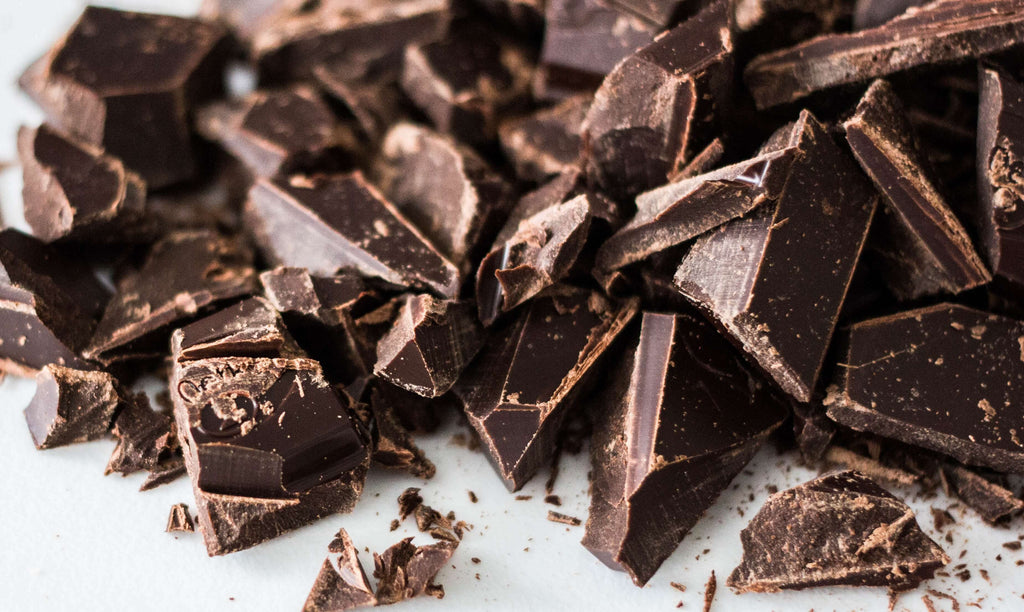
Why Can't Dogs Eat Chocolate?
Whether it contains real sugar or a substitute, vets say that all chocolate has the potential to be poisonous for dogs. Keep reading to learn the many reasons why chocolate is bad for dogs.
Why Can't Dogs Have Chocolate?
The main reason chocolate is toxic to dogs is because it contains a chemical compound called theobromine. Theobromine is a bitter alkaloid. It's naturally found in the cacao plant, and it's also in foods such as the kola nut and the leaves of many tea plants. Chocolate comes from the cacao plant, so it contains both theobromine and caffeine. These two chemicals are largely responsible for giving humans that “happy rush” they enjoy when they consume chocolate. Unfortunately, dogs don’t metabolize caffeine or theobromine in the way that humans can, which is why our pups are significantly more sensitive to the effects of these chemicals.
What Does Chocolate Do to Dogs?
Chocolate poisoning in dogs affects the heart, kidneys, and central nervous system the most. Symptoms typically occur between 4 and 24 hours after your dog has ingested chocolate, and they can last for 72 hours or more. The toxic side effects of chocolate depend greatly on the amount eaten, the type of chocolate ingested, and the size of the dog. If a larger dog eats 200 grams of milk chocolate, for example, he'll probably suffer from an upset stomach (i.e. vomiting and diarrhea). If it's 750 grams your beloved canine ingests, seizures, and cardiovascular problems are more of a concern.
What Are the Symptoms of Chocolate Poisoning in Dogs?
If your dog has eaten chocolate, stay calm. Investigate and attempt to determine how much she's eaten, what type of chocolate it was, and what the ingredients were. If you choose to wait a bit before visiting the veterinarian, just remember that the sooner your dog gets treatment, the more likely they are to recover without serious or long term side effects. Here are some clinical signs to look out for, should your furry friend dine on some form of chocolate:
- Agitation
- Nervousness
- Diarrhea
- Vomiting
- Rapid breathing
- Muscle tension or incoordination
- Seizures
- Increased heart rate
- Hyperactivity or restlessness
- Increased urination
- Tremors

What About the Other Types of Chocolate?
Death occurs as a result of consuming a significantly large quantity of chocolate rich in theobromine. Let’s examine the other types of chocolates and the amounts of theobromine they contain.
Dark Chocolate
Even a single 500-gram bar of dark chocolate can contain enough theobromine to kill a 70-pound Labrador. After a dog eats enough of any type of dark chocolate, fast and irregular heartbeats are the most common clinical sign. Additional symptoms could include seizures, tremors, vomiting, and even death.
Milk Chocolate
From candy to ice cream, milk chocolate exists in abundance. While its theobromine levels are lower than that of dark chocolate, it still contains enough to poison dogs.
Baker's or Semisweet Chocolate
Because of its extremely high levels of theobromine, you should keep baker's chocolate far away from your pup, always and forever. Its potency can be deadly for canines. More trouble lurks in the potential for additional ingredients. Foods like Macadamia nuts, raisins, and peanut butter contribute to the already-negative effects of baker’s chocolate. As a rule of paw, steer clear of giving your dog any foods containing chocolate. Chocolate cake, ice cream, cookies, chocolate milk, and so many other things we eat are loaded with this potential danger for dogs. Many of the common allergy symptoms our dogs suffer from, stems from the food they eat.
Cocoa Powder
Even more than baker's chocolate, cocoa powder's theobromine levels are significantly high. Unsweetened cocoa powder has been shown to possess the highest concentration of methylxanthines (theobromine) of all chocolate preparations.
What to Do If Your Dog Eats Chocolate
If your dog eats chocolate, you must determine how much chocolate they ate. Without knowing the details, it's difficult to determine what the effects will be. It's safe to say that your dog sneaking a few licks of your ice cream cone is much less dangerous than him eating a few squares of baker's chocolate. There's no harm in calling to check in with a medical professional who'll help you decide the best course of action for your loyal canine. If you can't get your vet on the phone, contact animal poison control. If the theobromine hasn't yet been absorbed, a veterinarian might only have to perform a checkup, induce vomiting, and give fluid therapy.
What Are Some Treatments?
Treatment depends on what kind of and how much chocolate was eaten. In addition to induced vomiting, activated charcoal may help to reduce the continuous recirculation and resorption of theobromine in some cases.
Why Can't Dogs Eat Chocolate?
Why can't dogs eat chocolate? The theobromine in chocolate is difficult for dogs to digest, and can be fatal if too much of it gets ingested. There are plenty of delicious treats for your pup that aren't dangerous, so try out some alternatives.




























